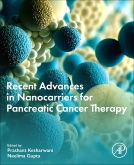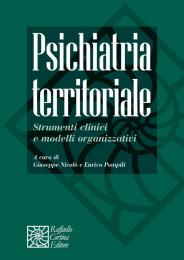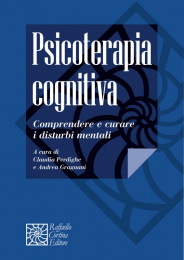Non ci sono recensioni
DA SCONTARE
Recent Advances in Nanocarriers for Pancreatic Cancer Therapy reviews thriving strategies concerning pancreatic cancer therapy, thoroughly describing the most recent developments in emerging modern drug delivery systems focused on, and derived from, nanotechnology. By providing a holistic understanding of the molecular pathways, conventional therapy and novel nanocarriers mediated drug delivery against pancreatic cancer, this work can be considered a complete package. The book offers a solution to the dissemination of data from a broad range of resources by providing an overview of the molecular pathways and conventional therapy of pancreatic cancer, the application of various nanocarriers, and more.
This book equips scientists, clinicians and students to make rational treatment approaches based on nanomedicine for improving and extending the human life against pancreatic cancer.
Part A Overview, molecular pathways and conventional therapy of pancreatic cancer
1. An overview of the anatomy, physiology, and pathology of pancreatic cancer
Farzad Rahmani and Amir Avan
1.1 Pancreas anatomy
1.2 Pancreas physiology
1.2.1 Endocrine pancreas
1.2.2 Exocrine pancreas
1.3 Pancreas cancer pathology
1.3.1 Pathology of the exocrine neoplasms of the pancreas
1.3.2 Pathology of the endocrine neoplasms of pancreas
1.4 Conclusion
References
2. Different combination therapies pertaining to pancreatic cancer
Zahra Salmasi, Parisa Saberi-Hasanabadi, Hamidreza Mohammadi and Rezvan Yazdian-Robati
2.1 Introduction
2.2 Carrier-free combination therapy in pancreatic cancer treatment
2.3 Nanoparticle-mediated combination therapy in pancreatic cancer treatment
2.3.1 Metal and metal oxide nanoparticles
2.3.2 Nonmetallic nanoparticles
2.3.3 Polymeric nanoparticles
2.3.4 Lipid-based nanoparticle
2.4 Combination treatment with chimeric antigen receptor T cells and oncolytic viruses
2.5 Compounds of natural origin and combination therapy in pancreatic cancer treatment
2.5.1 The role of bioactive compounds of natural origin based on nano-formulation in inhibiting the proliferation of pancreatic cancer cells
2.6 Conclusions and perspectives
References
Part B Application of various nanocarriers for the management of pancreatic cancer
3. Potential application of nanotechnology in the treatment and overcoming of pancreatic cancer resistance
Shwetapadma Dash, Sonali Sahoo and Sanjeeb Kumar Sahoo
3.1 Introduction
3.2 Current therapeutics for pancreatic cancer
3.2.1 Conventional therapies
3.2.2 Targeted therapies
3.3 Drug resistance as a pitfall
3.3.1 Role of drug uptake and drug metabolism pathways
3.3.2 Role of key signaling networks
3.3.3 Tumor microenvironment
3.3.4 Cancer stem cells and epithelial to mesenchymal transition as regulators
3.3.5 Other miscellaneous pathways and factors
3.4 Nanotechnology as a therapeutic window
3.4.1 Nanotherapeutic strategies using chemotherapeutic drugs
3.4.2 Nanotherapeutics-based approaches for targeting drug resistance
3.4.3 Nanotherapeutics-based approaches for targeting tumor microenvironment
3.4.4 Pro- and antiapoptotic genes: evasion and overexpression
3.4.5 Nanotherapeutic strategies for targeting cancer stem cells
3.4.6 Nanoparticles as delivery vehicles for RNA interference inhibitors
3.4.7 Nanomaterials for early detection and advancing pancreatic cancer imaging for pancreatic cancer
3.5 Conclusion
References
4. Application of hydrogel-based drug delivery system for pancreatic cancer
Naomi Sanjana Sharath, Ranjita Misra and Jyotirmoy Ghosh
4.1 Introduction
4.2 Pancreatic cancer
4.3 Physiology
4.3.1 Treatment
4.4 Limitations
4.5 Hydrogels
4.6 Types of polymers used in hydrogels
4.6.1 Natural polymers
4.6.2 Synthetic polymers
4.7 Preparation of hydrogels
4.7.1 Bulk polymerization
4.7.2 Solution polymerization
4.7.3 Optical polymerization
4.7.4 Enzymatic polymerization
4.8 Types of some common hydrogels
4.8.1 Injectable hydrogels
4.8.2 Temperature-sensitive hydrogels
4.8.3 pH-sensitive hydrogels
4.8.4 Photosensitive hydrogels
4.8.5 Electrosensitive hydrogels
4.9 Applications of hydrogels against pancreatic cancer
4.10 Diagnosis
4.10.1 Therapy
4.10.2 Organoid development for cancer treatment
4.11 Conclusion and future outlook
References
5. Liposome- and noisome-based drug delivery for pancreatic cancer
Rezvan Yazdian-Robati, Seyedeh Melika Ahmadi, Faranak Mavandadnejad, Pedram Ebrahimnejad, Shervin Amirkhanloo and Amin Shad
Abbreviations
5.1 Introduction
5.2 Liposome-based drug delivery
5.2.1 Components and structure of liposome
5.3 Liposomal drug delivery platforms for pancreatic cancer
5.3.1 Liposome-drugs to treat pancreatic cancer
5.3.2 Liposome—naturally derived bioactive compounds to treat pancreatic cancer
5.3.3 Liposomal delivery of CRISPR/Cas9 to treat PC
5.4 Targeted nanoliposomes for pancreatic cancer treatment
5.4.1 Transporter-targeted liposome for pancreatic cancer therapy
5.4.2 Antibody-decorated liposomes for pancreatic cancer
5.4.3 Peptide-decorated liposome
5.4.4 Carbohydrate-decorated liposomes
5.5 Stimuli-responsive liposomal nano-formulations for pancreatic cancer
5.5.1 pH-sensitive liposomes
5.5.2 Magnetic sensitive and ultrasound liposomes
5.5.3 Thermo-sensitive liposomes
5.6 Clinical studies of liposomal formulation for pancreatic cancer treatment
5.7 Noisome-based drug delivery
5.7.1 Structure and components of niosomes
5.7.2 Noisome drug delivery for pancreatic cancer treatment
5.8 Conclusion
Declaration of competing interest
References
6. Micelles-based drug delivery for pancreatic cancer
Sanjay Ch, Tarun Kumar Patel, Swati Biswas and Balaram Ghosh
6.1 Introduction
6.2 Micellar uptake mechanism
6.2.1 Endocytosis
6.2.2 Phagocytosis
6.2.3 Pinocytosis
6.2.4 Macropinocytosis
6.3 Polymeric micelles and their types
6.3.1 Conventional polymeric micelles
6.3.2 Polymeric micelles based on functionalities
6.4 Pancreatic cancertargeting sites for micelles
6.4.1 Epidermal growth factor
6.4.2 Transferrin
6.4.3 Urokinase plasminogen activator receptor
6.4.4 Fucosylated antigen
6.4.5 Integrins
6.5 Small interfering RNA-loaded micelles for pancreatic cancer therapy
6.6 Polymeric micelles in clinical studies for pancreatic cancer
6.7 Conclusion
References
7. Theranostic nanoparticles in pancreatic cancer
Sania Ghobadi Alamdari, Reza Mohammadzadeh, Behzad Baradaran, Mohammad Amini, Ahad Mokhtarzadeh and Fatemeh Oroojalian
7.1 Introduction
7.2 Metal nanoparticles
7.2.1 Gold nanoparticles
7.2.2 Iron oxide nanoparticles
7.2.3 Silica nanoparticles
7.2.4 Other metal nanoparticles
7.3 Polymeric nanoparticles
7.3.1 Natural polymer nanoparticles
7.3.2 Synthetic polymer nanoparticles
7.4 Carbon nanoparticles
7.5 Conclusion
References
8. Recent advances in nanocarriers for pancreatic cancer therapy
Shalini Preethi P., Sindhu V., Karthik Sambath, Arun Reddy Ravula, Geetha Palani, Sivakumar Vijayaraghavalu, Shanmuga Sundari I. and Venkatesan Perumal
8.1 Introduction
8.1.1 Cancer
8.1.2 Pancreatic cancer
8.1.3 Types of pancreatic cancer
8.2 Polymeric nanoparticles
8.2.1 Passive targeting
8.2.2 Active targeting
8.2.3 Responsive polymeric nanoparticles
8.2.4 pH-responsive polymeric nanoparticles
8.2.5 Synthesis of polymeric nanoparticles
8.2.6 Characterization of polymeric nanoparticles
8.3 Diagnosis
8.3.1 Risk factors
8.3.2 Detection of protein-based biomarkers in blood
8.3.3 Detection of nucleic-based biomarkers in blood
8.3.4 Imaging techniques
8.3.5 Electrochemical detection
8.4 Surgical management
8.4.1 Preoperative biliary drainage
8.4.2 Anastomotic technique
8.4.3 Minimally invasive surgery
8.4.4 Vascular resection
8.5 Medical management
8.5.1 Chemotherapy
8.5.2 Immunotherapy
8.5.3 Radiotherapy
8.5.4 Targeted therapy
8.5.5 Antibody-mediated therapy
8.5.6 Synergistic therapy
8.5.7 Radiodynamic therapy
8.6 Conclusion
References
9. Metallic nanoparticles-based drug delivery for pancreatic cancer
Sara Natalia Moya Betancourt, Jorge Gustavo Uranga, Viviana Beatriz Daboin, Paula Gabriela Bercoff and Julieta Soledad Riva
9.1 Introduction
9.2 Gold nanoparticles
9.3 Silver nanoparticles
9.4 Iron oxide nanoparticles
9.5 Other metallic nanoparticles (Pd, Pt, CuO, ZnO, TiO2)
9.6 Mesoporous silica nanoparticles
9.7 Conclusion
Acknowledgments
Conflicts of interest
References
10. Empowering treatment strategies for pancreatic cancer by employing lipid nanoparticle-driven drug delivery
Sumit Sheoran, Swati Arora, Aayushi Velingkar, Smita C. Pawar and Sugunakar Vuree
10.1 Introduction
10.2 Symptoms and risk factors of pancreatic cancer
10.2.1 The stages of pancreatic cancer?
10.3 Lipid nanoparticles
10.4 Solid lipid nanoparticles
10.5 Limitations of solid lipid nanoparticles and way to overcome
10.6 High pressure-induced drug degradation
10.7 Lipid crystallization and drug incorporation
10.8 Several colloidal species coexist
10.9 Nanostructured carriers of lipid (solid lipid nanoparticles and nanostructured lipid carriers)
10.9.1 Solid lipid nanoparticles and nanostructured lipid carriers for drug delivery
10.9.2 Solid lipid nanoparticles as delivery carriers for anticancer agents
10.9.3 Routes of delivering
10.10 Applications of solid lipid nanoparticles in pancreatic cancer
10.11 Conclusion
References
11. Solid lipid nanoparticle-based drug delivery for pancreatic cancer
Dipanjan Ghosh, Gouranga Dutta, Arindam Chatterjee, Abimanyu Sugumaran, Gopal Chakrabarti and Sivakumar Manickam
11.1 Introduction
11.2 Lipid classifications for solidlipid nanoparticle synthesis
11.3 Preparations techniques of solid lipid-based nanoparticles
11.3.1 High-pressure homogenization
11.3.2 Ultrasonication
11.3.3 Coacervation
11.3.4 Solvent emulsification evaporation
11.3.5 Microemulsions
11.4 Role of pancreatic lipase and lipid nanoparticle in pancreatic cancer therapy
11.5 Enhancing cancer therapeutic efficacy with lipid-based nanoparticles
11.5.1 Gemcitabine
11.5.2 Paclitaxel
11.5.3 Irinotecan
11.5.4 Capecitabine
11.5.5 5-fluorouracil
11.5.6 RNA-based delivery system
11.6 Future aspects
References
12. Dendrimers and carbon nanotubes-based drug delivery for pancreatic cancer
Mehmethan Yildirim, Durmus Burak Demirkaya and Serap Yalcin
12.1 A brief overview of pancreatic cancer
12.2 Drug delivery for cancer therapy
12.3 Carbon nanotubes
12.4 Dendrimers
12.4.1 Poly-L-lysine-based dendrimers
12.4.2 Polyamidoamine dendrimers
12.4.3 Polypropylene imine dendrimers
12.4.4 Frechet-type dendrimers
12.4.5 Core-shell tecto dendrimer
12.4.6 Chiral dendrimers
12.4.7 Liquid crystal dendrimers
12.4.8 Peptide dendrimers
12.4.9 Polyester dendrimers
12.5 Dendrimers and carbon nanotubes-based drug delivery for pancreatic cancer
12.6 Conclusion
References
Further reading
Part C Recent advances and future prospective for pancreatic cancer
13. Personalized medicine and new therapeutic approach in the treatment of pancreatic cancer
Hanieh Azari, Ghazaleh Khalili-Tanha, Elham Nazari, Mina Maftooh, Seyed Mahdi Hassanian, Gordon A. Ferns, Majid Khazaei and Amir Avan
13.1 Introduction
13.1.1 Pancreatic cancer: common treatment
13.2 Could personalized medicine transform healthcare?
13.2.1 What is personalized medicine?
13.2.2 Precision or personalized medicine: what’s the difference?
13.2.3 Advantages of personalized medicine
13.3 The role of personalized medicine in pancreatic cancer
13.4 Recent progress in personalized medicine for pancreatic cancer therapy
13.5 The molecular landscape of pancreatic cancer
13.6 Genomic subgroups
13.7 Transcriptomic subgroup
13.8 Predictive markers of pancreatic cancer for personalized therapy
13.9 Examples of precision medicine in pancreatic cancer
13.9.1 Patient derived xenograft
13.9.2 Patient’s derived organoid
13.10 The advantages of microfluidic devices
13.11 General scheme of producing a pancreatic organoid
13.12 Some applications of pancreatic organoids
13.12.1 RNA-based therapeutic tool for personalized PDAC treatment
13.12.2 Radiomics and deep learning in personalized medicine
13.13 The quantitative imaging methods for pancreatic cancer diagnosis, prognosis, and prediction
13.14 Challenges and innovations in personalized medicine care
13.15 Challenges in the treatment of pancreatic cancer
13.16 The challenges from an oncologist’s perspective
13.17 Opportunities for personalized therapy in the near future
13.18 Conclusion
Declarations of interest
References
14. Clinical practice guidelines for interventional treatment of pancreatic cancer
Ghazaleh Pourali, Ghazaleh Donyadideh, Shima Mehrabadi, Mina Maftooh, Seyed Mahdi Hassanian, Gordon A. Ferns, Majid Khazaei and Amir Avan
14.1 The definition of pancreatic cancer and its classification in clinic
14.2 Incidence and epidemiology and risk factors
14.2.1 Modifiable risk factors
14.2.2 Nonmodifiable risk factors
14.3 Surgical treatment of pancreatic cancer
14.4 Nonsurgical therapies
14.4.1 Chemotherapy
14.4.2 Chemoradiotherapy
14.4.3 Radiotherapy
14.4.4 Ablative techniques
14.5 Treatment in metastatic patient
14.5.1 First-line chemotherapy
14.5.2 Second-line chemotherapy
14.5.3 Side effects and future perspective
Grant
Conflict of interest
References
15. Aptamer-mediated nano-therapy for pancreatic cancer
Seyyed Mobin Rahimnia, Sadegh Dehghani, Majid Saeedi, Amin Shad and Rezvan Yazdian-Robati
15.1 Introduction
15.2 Nanotechnology as a novel cancer therapeutic strategy
15.3 Aptamers as an advance targeted strategy in cancer diagnosis and treatment
15.4 Aptamer design approaches
15.5 Methods for coupling aptamers to nanoparticles
15.6 Tumor markers for pancreatic cancer
15.7 Aptamers against pancreatic cancer
15.8 Aptamers in clinical trials for pancreatic cancer
15.9 Aptamer-functionalized nanocarriers against pancreatic cancer
15.9.1 Aptamer-functionalized calcium phosphosilicate nanoparticles
15.9.2 Aptamer-functionalized gold nanoparticles
15.9.3 Aptamer-functionalized lipid nanoparticles
15.9.4 Aptamer-functionalized magnetic nanoparticles for treatment of pancreatic cancer
15.9.5 Aptamer-functionalized polymeric nanoparticles
15.9.6 Aptamer-functionalized albumin nanoparticles
15.10 Conclusion
Conflict of interest
References
16. Photodynamic therapy for pancreatic cancer
Rezvan Yazdian-Robati, Atena Mansouri, Peyman Asadi, Mehdi Mogharabi-Manzari and Mohsen Chamanara
16.1 Pancreatic cancer
16.2 Principles of photodynamic therapy
16.3 Elements of photodynamic therapy
16.3.1 Photosensitizers agents in photodynamic therapy
16.3.2 Light (600800 nm)
16.3.3 Oxygen
16.4 Nanoparticles mediated photodynamic therapy for pancreatic cancer
16.5 Combination of photodynamic therapy with other therapies in pancreatic cancer treatment
16.5.1 Combination of photodynamic therapy with radiation therapy
16.5.2 Combination of photodynamic therapy with immunotherapy
16.5.3 Combination of photodynamic therapy with chemotherapy
16.5.4 Combination of photodynamic therapy with chemotherapy and immunotherapy
16.5.5 Combination of photodynamic therapy with sonodynamic therapy
16.5.6 Combination of photodynamic therapy with photothermal therapy
16.6 Summary and outlook
Declaration of competing interest
References
17. Future prospect of nano-based drug delivery approaches against pancreatic cancer and expected pitfalls of the technology
K.R. Manu, Gurleen Kaur, Ananya Kar, Lopamudra Giri, Waleed H. Almalki, Neelima Gupta, Amirhossein Sahebkar, Prashant Kesharwani and Rambabu Dandela
17.1 Introduction
17.2 Conventional therapy for pancreatic cancer
17.2.1 Surgery
17.2.2 Chemotherapy
17.2.3 Radiation therapy
17.2.4 Targeted therapy
17.3 The prospects of nanotechnology in pancreatic cancer treatment
17.4 Applications of various types of nano-based drug delivery systems for pancreatic cancer therapy
17.4.1 Hydrogel-based drug delivery systems
17.4.2 Nanoemulsion-based drug delivery systems
17.4.3 Liposome- and niosome-based drug delivery systems
17.4.4 Polymeric nanoparticlebased drug delivery systems
17.4.5 Micelle-based drug delivery systems
17.4.6 Metallic nanoparticlebased drug delivery systems
17.4.7 Solid lipid nanoparticlebased drug delivery systems
17.4.8 Quantum dotbased drug delivery systems
17.4.9 Dendrimer-based drug delivery systems
17.4.10 Carbon nanotubebased drug delivery systems
17.5 Challenges of nano-based drug delivery system for pancreatic cancer therapy
17.6 Conclusion and future perspective
Acknowledgments
Reference
Index




